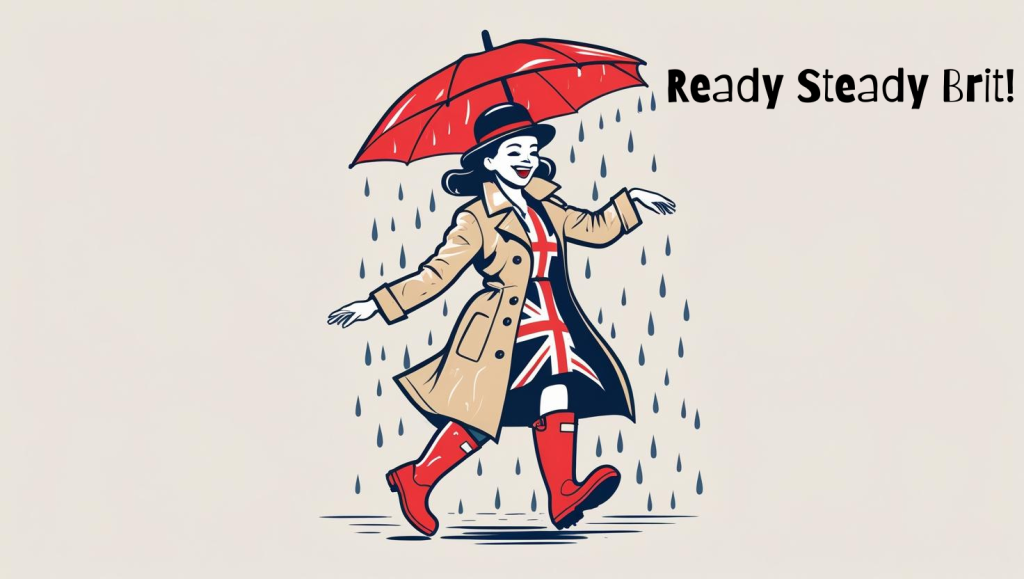Welcome to Britain. Land of drizzle, queuing, apologising unnecessarily—and speaking a version of English that makes even native English speakers from elsewhere ask, “Sorry, what?”
If you’ve ever wondered why Brits say “cheers” when they’re not drinking, or why someone called you “mate” after cutting in front of you, don’t worry. You’re about to get the basics (with just the right amount of sass) from your friends at Ready Steady Brit.
1. First Things First: Drop the ‘R’
British English is famously non-rhotic, which basically means we drop our R’s unless they’re followed by a vowel.
- “Water” becomes waw-tuh
- “Car” sounds like cah
- “Butter” is buh-uh, delivered with an optional disapproving look
Top tip: Practice while drinking tea with your pinkie finger raised.
2. How to Greet Without Actually Saying Hello
Brits love a good sidestep around a direct “hello”. Try one of these classics:
- “Alright?” (Translation: Hello, I acknowledge your presence.)
- “How’s it going?” (Don’t expect a real answer.)
- “You OK?” (Not actually concerned—just saying hi.)
Danger zone: Don’t panic if someone says “You alright?” It’s not an insult. You haven’t got spinach in your teeth. It’s just… British.
3. Master the Art of Saying One Thing and Meaning Another
British English is a language built on euphemism, understatement, and passive aggression. Behold:
| British Phrase | Actual Meaning |
|---|---|
| “That’s interesting” | I hate it. |
| “Bit of a pickle” | This is a disaster. |
| “I’m not being funny but…” | Prepare to be offended. |
| “It’s fine.” | It’s absolutely not fine. |
| “I might have a look later.” | I never will. |
4. Politeness Is Power
Brits are fluent in politeness. You’ll need:
- “Sorry” (for things that weren’t your fault)
- “Please” (even if you’re furious)
- “Thank you” (even when leaving a bus)
Bonus point: If someone steps on your foot, you still say sorry.
5. The Big Three: Cheers, Mate, and Bloody
Let’s break down your essential starter pack.
- Cheers – Can mean “thanks”, “bye”, or “I’m raising this pint to you”.
- Mate – Used for friends, strangers, enemies, and people you don’t trust one bit. It’s all in the tone.
- Bloody – A safe, semi-sweary intensifier for beginners.
Example: “It’s bloody freezing, mate.”
6. British Slang Starter Kit
Dip your toes in the slang pool:
- Gobsmacked – Shocked (the good kind, or the bad)
- Knackered – Exhausted
- Fancy a cuppa? – Want tea, chat, comfort, possibly a biscuit?
- Chuffed – Proud or pleased
- Gutted – Devastated (but still pretending everything’s fine)
7. Posh vs Proper vs “A Bit of a Lad”
Not all English sounds the same. There’s posh (think royal family), proper (BBC-style), and then your regional flavours—Cockney, Scouse, Geordie, Brummie, and dozens more. You probably won’t understand half of them at first. Neither do we.
8. Bonus: How to Survive Small Talk
You must know how to:
- Comment on the weather (it’s awful, always)
- Complain about trains (late, always)
- Moan about the price of everything (especially Freddos)
Examples:
- “Typical, isn’t it?” (Used during rain, delays, or political scandals)
- “Can’t believe the state of this country!” (Used for… anything)
Final Tip: Say It Like You’re Sorry
Even if you’re confident, say things like you’re not quite sure. It’s very British. Shrug a little. Look unsure. End everything with a question tag:
- “It’s cold today, isn’t it?”
- “That’s lovely, that is.”
- “Don’t want to be a bother, but…”
